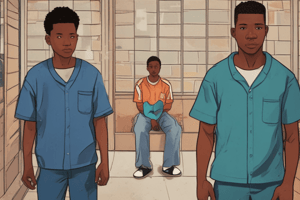Podcast
Questions and Answers
What was a key change in the treatment of juvenile delinquents in the early 20th century?
What was a key change in the treatment of juvenile delinquents in the early 20th century?
- Compulsory military service was mandated.
- The introduction of a formal juvenile justice system. (correct)
- Youth were given full rights as citizens.
- They were treated equally to adult offenders.
How was the term 'adolescence' perceived before the 20th century?
How was the term 'adolescence' perceived before the 20th century?
- It was a widely used term in social discussions.
- It rarely existed as a distinct phase of life. (correct)
- It was associated only with wealthy children.
- It was only used in legal contexts.
What does the concept of parens patriae refer to?
What does the concept of parens patriae refer to?
- A system where adults take full responsibility for juvenile crimes.
- An argument against the establishment of a juvenile system.
- A legal principle emphasizing punishment over rehabilitation.
- A philosophy focusing on the state as a guardian for minors. (correct)
What was a primary concern that led to reforms in the late 19th century regarding youth?
What was a primary concern that led to reforms in the late 19th century regarding youth?
What sparked the 'child savers' movement?
What sparked the 'child savers' movement?
Which statement about youth in historical perspective is true?
Which statement about youth in historical perspective is true?
What social changes contributed to the emergence of adolescence as a distinct phase?
What social changes contributed to the emergence of adolescence as a distinct phase?
What did the Juvenile Delinquents Act of 1908 primarily establish in Canada?
What did the Juvenile Delinquents Act of 1908 primarily establish in Canada?
Flashcards are hidden until you start studying
Study Notes
Youth Delinquency in Canada: A Historical Perspective
- There's a lack of official data on youth in conflict with the law in Canada's historical context, making it difficult to gauge the extent of the issue.
- Prior to the 20th century, the term "adolescence" was rarely used, and young people were usually integrated into economic and social life.
- The modern concept of adolescence emerged as a distinct age-based social category, leading to concerns about youth deviance.
- In the late 19th century, compulsory education was introduced in Canada to combat the perceived corrupting influence of street life and address the influx of destitute children from Britain (over 90,000).
- This period saw a shift toward treating "problem children" differently from adults, leading to the rise of the modern juvenile justice system.
- Early youth justice reforms were influenced by international trends, emphasizing the concept of diminished moral blameworthiness.
- Parens patriae, the principle of the state acting as a protective parent, and the "best interests of the child" became central to juvenile justice.
- The "child savers" movement advocated for alternative approaches to address juvenile delinquency, moving away from harsh punishments.
- The 1908 Juvenile Delinquents Act (JDA) marked the official start of juvenile delinquency in Canada's legal history, separating young offenders from adults.
- The JDA reflected a growing awareness of the need for rehabilitation rather than harsh incarceration for young offenders.
Studying That Suits You
Use AI to generate personalized quizzes and flashcards to suit your learning preferences.




